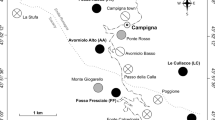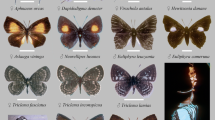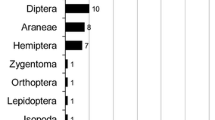Abstract
The majority of army ant species forage hypogaeically. Due to the difficulties in observing these ants, their potential influence on hypogaeic and epigaeic arthropod communities has not yet been investigated. As the first hypogaeically foraging army ant studied in detail, we attracted Dorylus laevigatus to areas monitored for their arthropod diversity. Here, for the first time, the same sites were sampled before and after an army ant raid. Furthermore, interactions between D. laevigatus and the five most common ground-nesting ant species were noted and their life-history traits compared, allowing first inferences on possible mechanisms of their coexistence. The occurrence of D. laevigatus within a study plot had no evident effect on the number of arthropod taxa or individuals collected with epigaeic and hypogaeic pitfall traps. Likewise, juvenile arthropods, which are less mobile and thus are potentially easier prey for D. laevigatus, showed no differences in their collected numbers before and after the army ant had visited a plot. However, significantly fewer ant species were collected with hypogaeic traps after D. laevigatus had been within the study plots, indicating a possible predation of D. laevigatus especially on two Pseudolasius and one Pheidole species. The five most common ground-foraging ant species demonstrated their ability to avoid, kill, and even prey on the army ant. The reaction of Lophomyrmex bedoti towards D. laevigatus indicated the former to be a potential prey species, while Pachycondyla sp. 2 showed signs of "enemy specification." Odontoponera diversus and O. transversa actively preyed on D. laevigatus, while Pheidologeton affinis fought with D. laevigatus over resources. All ant species could co-occur with D. laevigatus at palm oil baits. Adding to the differences detected in previous studies between D. laevigatus and epigaeically foraging army ant species, the occurrence of this hypogaeic army ant seems to have less devastating effects on arthropod community compositions than those of epigaeically mass raiding species.


Similar content being viewed by others
References
Berghoff SM, Weissflog A, Linsenmair KE, Hashim R, Maschwitz U (2002a) Foraging of a hypogaeic army ant: a long neglected majority. Insectes Soc 49:133–141
Berghoff SM, Weissflog A, Linsenmair KE, Mohamed M, Maschwitz U (2002b) Nesting habits and colony composition of the hypogaeic army ant Dorylus (Dichthadiu) laevigatus Fr. Smith. Insectes Soc 49:380–387
Berghoff SM, Gadau J, Winter T, Linsenmair KE, Maschwitz U (2003) Sociobiology of hypogaeic army ants: description of two sympatric Dorylus species on Borneo and their colony conflicts. Insectes Soc (in press)
Bestelmeyer BT, Agosti D, Alonso LE, Brandao CRF, Brown WL Jr, Delabie JHC, Silvestre R (2000) Field techniques for the study of ground-dwelling ants. An overview, description, and evaluation. In: Agosti D, Majer JD, Alonso LE, Schultz TR (eds) Ants. Standard methods for measuring and monitoring biodiversity, Smithsonian Institution Press, Washington, DC, pp 122–144
Bolton B (1994) Identification guide to the ant genera of the world. Harvard University Press, London
Brosset A (1988) Le peuplement de mammifires insectivores des forets du Nord-Est du Garbon. Rev Ecol (Terre Vie) 43:23–46
Darlington JPEC (1985) Attacks by doryline ants and termite nest defences (Hymenoptera; Formicidae; Isoptera; Termitidae). Sociobiology 11:189–200
Droual R (1984) Anti-predator behavior in the ant Pheidole desertorurn: the importance of multiple nests. Anim Behav 32:1054–1058
Franks NR (1982a) Ecology and population regulation in the army ant Eciton burchelli. In: Leigh EG, Rand AS, Windsor DM (eds) The ecology of a tropical forest: seasonal rhythms and long-term changes, Smithsonian Institution Press, Washington, DC, pp 389–395
Franks NR (1982b) Social Insects in the aftermath of swarm raids of the army ant Eciton burchelli. In: Breed MD, Michener CD, Evans HE (eds) The biology of social insects, Westview Press, Boulder, Colo, p 419, pp 275–279
Franks NR, Bossert WH (1983) The influence of swarm raiding army ants on the patchiness and diversity of a tropical leaf litter ant community. In: Sutton SL, Whitmore TC, Chadwick AC (eds) Tropical rain forest: ecology and management, Blackwell, Oxford, pp 151–163
Gotwald WH Jr (1974a) Foraging behavior of Anomnza driver ants in Ghana cocoa farms (Hymenoptera: Formicidae). Bull l'I F A N 36:705–713
Gotwald WH, Jr (1974b) Predatory behavior and food preferences of driver ants in selected African habitats. Ann Entomol Soc Am 67:877–886
Gotwald WH Jr (1978) Trophic ecology and adaptation in tropical old world ants of the subfamily Dorylinae (Hymenoptera: Formicidae). Biotropica 10:161–169
Gotwald WH Jr (1982) Army ants. In: Hermann HR (ed) Social insects, vol 4. Academic Press, New York
Gotwald WH Jr (1995) Army ants: the biology of social predation. Cornell University Press, Ithaca, NY
Greenslade PJM (1973) Sampling ants with pitfall traps: digging-in effects. Insectes Soc 20:343-353
Hirosawa H, Higashi S, Mohamed M (2000) Food habits of Aenictus army ants and their effects on the ant community in a rain forest of Borneo. Insectes Soc 47:42–49
Hölldobler B (1979) Territories of the African weaver ant (Oecophyllu longinodu [Latreille]). Z Tierpsychol 51:201–213
LaMon B, Topoff H (1981) Avoiding predation by army ants: defensive behaviours of three ant species of the genus Camponotus. Anim Behav 29:1070–1081
Moffett MW (1988) Foraging dynamics in the group-hunting myrmicine ant, Pheidologeton diversus. J lnsect Behav 1:309–331
Otis GW, Santana EC, Crawford DL, Higgins ML (1986) The effect of foraging army ants on leaf-litter arthropods. Biotropica 18:56–61
Perfecto I (1992) Observations of a Lubidus coecus (Latreille) underground raid in the central highlands of Costa Rica. Psyche 99:214–220
Quiroz-Robledo L, Valenzuela-González J (1995) A comparison of ground ant communities in a tropical rainforest and adjacent grassland in Los Tuxtlas, Veracruz, Mexico. Southwest Entomol 20:203-213
Rettenmeyer CW, Chadab-Crepet R, Naumann MG, Morales L (1980) Comparative foraging by neotropicd army ants. Social Insects in the Tropics. University Paris-Nord, Cocoyoc, Morelos, Mexico
Roberts DL, Cooper RJ, Petit W (2000) Use of premontane moist forest and shade coffee agroecosystems by army ants in western Panama. Conserv Biol 14:192–199
Schneirla TC (1934) Raiding and other outstanding phenomena in the behavior of army ants. Proc Natl Acad Sci USA 20:316–321
Topoff H, Mirenda H, Droual R, Hemck S (1980) Behavioral ecology of mass recruitment in the army ant Neivamynnex nigrescens. Anim Behav 28:779–789
Weissflog A, Sternheim E, Dorow WHO, Berghoff S, Maschwitz U (2000) How to study subterranean army ants: a novel method for locating and monitoring field populations in the South East Asian army ant Dorylus (Dichthadia) laevigatus Smith, 1857 (Formicidae, Dorylinae) with observations on their ecology. Insectes Soc 47:317–324
Wilson EO (1975) Enemy specification in the alarm-recruitment system of an ant. Science 190:798–800
Witte V, Maschwitz U (2000) Raiding and emigration dynamics in the ponerine army ant Leptogenys distinguenda (Hymenoptera, Formicidae). Insectes Soc 47:76–83
Acknowledgements
We wish to thank the Economic Planning Unit, Sabah Parks, Maryati Mohamed of the University Malaysia Sabah, and Rosli Hashim of the University Malaya for their cooperation enabling the conduction of this study. Furthermore, we thank Marc Schäfer for his assistance in the field and two anonymous referees for their comments on the manuscript. Financial support was provided by the Deutsche Forschungsgemeinschaft (DFG Ma373/17–7).
Author information
Authors and Affiliations
Corresponding author
Rights and permissions
About this article
Cite this article
Berghoff, S.M., Maschwitz, U. & Linsenmair, K.E. Influence of the hypogaeic army ant Dorylus (Dichthadia) laevigatus on tropical arthropod communities. Oecologia 135, 149–157 (2003). https://doi.org/10.1007/s00442-002-1173-4
Received:
Accepted:
Published:
Issue Date:
DOI: https://doi.org/10.1007/s00442-002-1173-4




